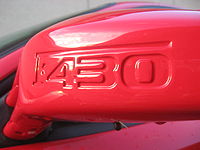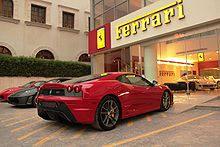Ferrari F430
 | |
| Manufacturer | Ferrari |
|---|---|
| Also called | 430 |
| Production | 2004–2009 |
| Assembly | Maranello, Italy |
| Predecessor | Ferrari 360 |
| Successor | Ferrari 458 Italia |
| Class | Sports car |
| Body style | 2-seat Berlinetta 2-seat Spider |
| Layout | Rear mid-engine, rear-wheel drive |
| Engine | 4.3 L V8 |
| Transmission | 6-speed manual 6-speed 'F1' electrohydraulic manual |
| Wheelbase | 102.4 in (2,601 mm) |
| Length | 177.6 in (4,511 mm) |
| Width | 75.7 in (1,923 mm) |
| Height | Coupe: 47.8 in (1,214 mm) Spider: 48.6 in (1,234 mm) |
| Curb weight | 1,450 kg (3,197 lb) |
The Ferrari F430 is a sports car that was produced by the Italian automaker Ferrari from 2004 to 2009, as a successor to the 360. It debuted at the 2004 Paris Motor Show. Its replacement, the Ferrari 458 Italia, was unveiled on 28 July 2009.
Overview
The MSRP for a Ferrari F430 was $186,925 to $217,310 in the United States, £118,500 in the United Kingdom, approximately €175,000 in the European Union and $379,000 for the base model to $450,000 for the Spider F1 in Australia.
Design
The body of the F430 was redesigned from its predecessor, the 360, to be more curvaceous and aerodynamic. Although the drag coefficient remained the same, downforce was greatly enhanced. A great deal of Ferrari heritage was included in the exterior design. At the rear, the Enzo's tail lights and interior vents were added. The car's name was etched into theTestarossa-styled driver's side mirror. The large oval openings in the front bumper are reminiscent of Ferrari racing models from the 60s, specifically the 156 "sharknose" Formula One car and 250 TR61Le Mans cars of Phil Hill.
Engine
The F430 features a 4.3L V8 petrol engine derived from a shared Ferrari/Maserati design. This new power plant was a significant departure for Ferrari, as all previous Ferrari V8s were descendants of the Dino racing program of the 1950s. This fifty year development cycle came to an end with the entirely new 4.3L, the architecture of which is expected to replace the Dino-derived V12 in most other Ferrari cars. The engine's output specifications are: 490 PS (360 kW; 483 hp) at 8500 rpm and 465 N·m (343 lb·ft) of torque at 5250 rpm, 80% of which is available below 3500rpm. Despite a 20% increase in displacement, engine weight grew by only 4 kg and engine dimensions were decreased, for easier packaging. The connecting rods, pistons and crankshaft were all entirely new, while the four-valve cylinder head, valves and intake trumpets were copied directly from Formula 1 engines, for ideal volumetric efficiency. The F430 has a top speed of 196 mph (315 km/h) and can accelerate from 0 to 62 mph (100 km/h) in 4.0 seconds, 0.3 seconds quicker than the old model.
Brakes
The brakes on the F430 were designed in close cooperation with Brembo, resulting in a new cast-iron alloy for the discs. The new alloy includes molybdenum which has better heat dissipation performance. The F430 was also available with the optional Carbon fibre-reinforced Silicon Carbide (C/SiC) ceramic composite brake package. Ferrari claims the carbon ceramic brakes will not fade even after 300-360 laps at their test track.
Features
The F430 featured the E-Diff, a computer-controlled limited slip active differential which can vary the distribution of torque based on inputs such as steering angle and lateral acceleration.
Other notable features include the first application of Ferrari's manettino steering wheel-mounted control knob.[1] Drivers can select from five different settings which modify the vehicle's ESC system, "Skyhook" electronic suspension, transmission behavior, throttle response, and E-Diff. The feature is similar to Land Rover's "Terrain Response" system.
The Ferrari F430 was also released with exclusive Goodyear Eagle F1 GSD3 EMT tires, which have a V-shaped tread design, run-flat capability, and OneTRED technology.
In the US, the company requested an exemption from the airbag design requirements, which was eventually granted, allowing the car to continue to be sold in the US.
Variants
F430 Spider
The F430 Spider is the convertible version based on the coupé. The F430 Spider is Ferrari's 21st road going convertible.
The Ferrari F430 Spider made its world premiere at the Geneva motor show. The car was designed by Pininfarina with aerodynamic simulation programs also used for Formula 1 cars.
The roof panel automatically folds away inside a space above the engine bay. The conversion from a closed top to an open-air convertible is a two-stage folding-action.
The interior of the Spider is identical to that of the coupé.
F430 Challenge
The F430 Challenge is the track version of the F430, designed for the Ferrari Challenge. The engine remained untouched but the vehicle's weight was reduced, resulting in a top speed of 196 mph (315 km/h). The production model was unveiled at the Los Angeles Auto Show in January, 2005.
F430 GT2
Built to replace the 360 GT-C in 2006, the GT2 is a racing car designed to compete in international GT2 class competition, such as in the American Le Mans Series, Le Mans Series, and FIA GT Championship. F430 GT2s also compete at the 24 Hours of Le Mans. The GT2 was the fastest and most developed racing version of the F430.
In FIA GT2 championship, in order to render the car performances more uniform, the cars are forced to run with a specific minimum weight and with an engine restrictor that depends on the engine displacement. Hence the 4.3 L V8 engine in GT2 races is destroked to 4.0 L in order to compete in the 3.8–4.0 L class, which is allowed to race with a minimum weight of 1,100 kg (2,425 lb).Using the 4.3 L engine, the minimum weight of the F430 would increase by 50 kg (110 lb). In this race configuration, the engine produces somewhat less power, but this is compensated by the lower car weight, which yields a better weight/power ratio.
The F430 GT2s won their class championships in the ALMS and FIA GT, as well as scoring a class win at the 2007 12 Hours of Sebring.
F430 GT3
Originally based on the F430 Challenge, the F430 GT3 is a specialized racing car designed for the FIA GT3 European Championship and is also used in other national GT championships such as British GT and FFSA GT. It is mechanically similar to the F430 Challenge, but has better developed aerodynamics and more power.
The car uses the same 4.3 L V8 engine, tuned to produce 550 hp (410 kW; 558 PS), making the GT3 more powerful than its GT2 counterpart. However, due to the GT3 regulations stating that the car must have a power-to-weight ratio of around 2.6 kg/hp, the car weighs 1,219 kg (2,687 lb) in race trim (driver and fuel excluded), which is roughly 119 kg (262 lb) more than the GT2 spec car. Despite the higher power, it is significantly slower than the GT2 version; for example, in the 2007 Spa 24 hours endurance race, in which both models were entered, the GT3 spec vehicles' best qualification time was around 8 seconds slower per lap than that set by the GT2 spec vehicle.
430 Scuderia
Serving as the successor to the Challenge Stradale, the 430 Scuderia (scuderia meaning "stable of horses", but also used in the context of motor racing teams, including Ferrari's own) was unveiled by Michael Schumacher at the 2007 Frankfurt Auto Show. Aimed to compete with cars like the Porsche RS-models and the Lamborghini Gallardo Superleggera (superleggera meaning super light weight), it is lighter (by 100 kg/220 lb) and more powerful (515 PS (379 kW; 508 hp) at 8500 rpm) than the standard F430. Increased power comes from a revised intake, exhaust, and an ion-sensing knock-detection system that allows for a higher compression ratio. Thus the weight-to-power ratio is reduced from 2.96 kg/hp to 2.5 kg/hp. In addition to the weight saving measures, the Scuderia semi-automatic transmission gained improved "Superfast", known as "Superfast2", software for faster 60 millisecond shift-times. A new traction control system combined the F1-Trac traction and stability control with the E-Diff electronic differential. The Ferrari 430 Scuderia accelerates from 0-100 kilometres per hour (62 mph) in 3.6 seconds, with a top speed of 198 miles per hour (319 km/h). Ferrari claims that around their test track, Fiorano Circuit, it is faster than a Ferrari Enzo.
When tested on Top Gear, Jeremy Clarkson said "It appears to have been welded together by apes", referring to the exposed metalwork. However, he also said that it was a knife-edge racer, which is how a Ferrari should be. He was deeply impressed with its performance, and said that it blew away any Lamborghini. When given to the Stig to take around the Top Gear Test Track, it completed the circuit in an impressive 1 minute 19.7 seconds - as fast as the Nissan GT-R, but faster than the Mercedes-Benz SLR McLaren (1:20.9) and the Porsche Carrera GT (1:19.8). However, it was still slower than the Lamborghini Gallardo LP560-4 (1:19.5).
Scuderia Spider 16M
 |
|
To commemorate Ferrari's 16th victory in the Formula 1 Constructor's World Championship 2008, Ferrari unveiled the Scuderia Spider 16M at World Finals in Mugello. It is a convertible version of the 430 Scuderia.
The engine produces 510 PS (375 kW; 503 hp) at 8500 rpm and 470 N·m (350 lb·ft) torque at 5250 rpm. The car has a dry weight of 1,340 kg (2,954 lb) (80 kg lighter than the F430 Spider) and a curb weight of 1,440 kg (3,175 lb). It accelerates from 0-100 km/h (62 mph) in 3.7 seconds, with a top speed of 315 km/h (196 mph).
499 vehicles were released beginning early 2009.
F430 Spider Bio Fuel
A version of the F430 Spider that runs on ethanol, called the F430 Spider Bio Fuel, was on display at the 2008 Detroit Auto Show. It contained the same 4.3 litre V8 engine, producing 500 hp (373 kW), with a 4% increase in torque, with 5% less carbon dioxide emissions than the standard F430 Spider.
SP1
The F430-based Ferrari SP1 (Special Project Number 1), was the first one-off special produced by the Ferrari Portfolio Program. The body was designed by former Pininfarina designer Leonardo Fioravanti, at the behest of Junichiro Hiramatsu, a Japanese businessman who was the former president of the Ferrari Club of Japan and an avid collector; he had admired Fioravanti's 1998 F100 prototype.










![Validate my RSS feed [Valid RSS]](valid-rss-rogers.png)















































































ไม่มีความคิดเห็น:
แสดงความคิดเห็น